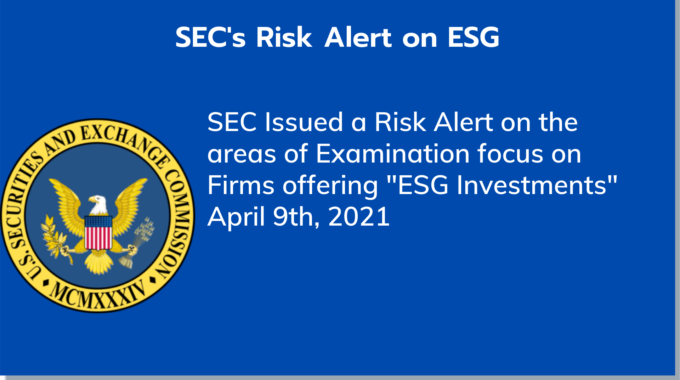Medium, John Hale, April 16 , 2021
Transparency is key
The U.S. Securities and Exchange Commission’s Division of Examinations released a Risk Alert last week on ESG investing resulting from recent examinations of advisors who serve clients directly or who offer ESG models and separately managed accounts, as well as those who offer public funds.
Beyond its rather portentous title, however, the Risk Alert doesn’t pass judgment on the merits of ESG approaches nor does it say the field is a risky mess. Nor, for that matter, does it give any indication of how many examinations it has conducted, making it hard to tell how widespread any issues they discuss really are.
But for advisors offering ESG options to their clients and for ESG funds, its fairly simple message boils down to this: Say what you mean and mean what you say.
On the one hand, this is exactly the same set of expectations that apply to any investment approach. On the other hand, the use of ESG evaluations, exclusions, and impact assessments alongside traditional investment criteria adds complexity not seen in investments that don’t consider ESG issues. And many practitioners are new to the game.
Implications for Advisors
If you are an advisor selecting ESG funds for clients, make sure the funds are actually aligned with the way you depict ESG to your clients. If your client has very specific criteria surrounding exclusions, make sure the funds you select follow the same criteria and have a monitoring process in place. Make sure your compliance personnel and procedures are up to speed on ESG matters.
I think it’s better for advisors to first seek out the funds they prefer to use for most ESG clients, develop a thorough understanding of how those offerings incorporate ESG, and then make sure clients understand it. Working from the other direction, first coming up with specific, customized ESG criteria for clients and then searching for, and monitoring, appropriate investments can be much more difficult. ESG investing doesn’t have to mean a unique, customized approach for every client.
Implications for Funds
If you run an ESG fund, you need to make clear how ESG factors weigh in investment decisions, both in terms of individual security selection and overall portfolio construction. For example, are ESG criteria used mainly to narrow the universe, and then security selection proceeds on the basis of traditional investment factors? Are ESG criteria used as a target for the overall portfolio? (I think of this as a portfolio ESG “budget” that allows for some poor ESG performing investments so long as the overall portfolio meets certain ESG-related standards.) Or are ESG criteria used alongside many other factors and may or may not be central to any given investment decision? If you use exclusions, are they well-defined and monitored? And finally, is what you are saying about ESG-related engagements and proxy voting accurate?
Best practices, to me, include a clear and thorough statement of the fund’s approach to ESG — this could entail a mix of several of the approaches mentioned above — and examples of how decisions are made. This should be updated at least annually. It would also be helpful to know more about company-level ESG evaluations, which are often not disclosed, and about which companies did not make it into the portfolio because they failed the fund’s ESG criteria.
Engagement targets should be identified, including those for whom the engagement was unsuccessful. Proxy voting policies should be clearly defined and communicated at the beginning of each proxy season, with updates provided, including actual votes. Even though funds are only required to report their proxy votes by Aug. 1, there is no good reason for them to wait. Do it in real time! Engagement and proxy voting resonates with ESG investors, so the more transparency around this, the better.
Transparency, in fact, is what it all comes down to. ESG investing demands more transparency of public companies; those who practice it should be more than willing to demand it of themselves.







